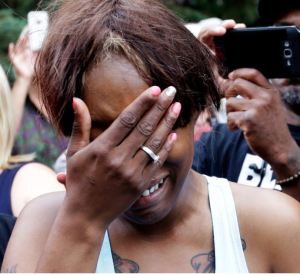By B.L. Ochman
Sure, what you see on Facebook Live is often a lot of bland talk. But this week, a Facebook Live video of the police murder of Philando Castile changed journalism forever.
 Hours after it was posted, Facebook took down the Facebook Live video of 32 year-old Castile’s murder posted by his girlfriend, Diamond Reynolds.
Hours after it was posted, Facebook took down the Facebook Live video of 32 year-old Castile’s murder posted by his girlfriend, Diamond Reynolds.
An hour later, they put it back up, with a warning about its graphic content. It has since been viewed over 5.5 million times.
News reporting will never be the same.
The issue of whether the videos should be removed is both complex and thorny. My vote is that they should stay.
Castile’s girlfriend, Diamond Reynolds, told the Los Angeles Times “I wanted everyone in the world to know that no matter how much the police tamper with evidence, how much they stick together … I wanted to put it on Facebook and go viral so that the people could see,” And we did.
Mark Zuckerberg made a statement on his Facebook page: “While I hope we never have to see another video like Diamond’s, it reminds us why coming together to build a more open and connected world is so important — and how far we still have to go,” he said.
Standards for the new reality
This is today’s new reality. If Facebook really wants to dominate the news, this is the way it’s going to happen.
Facebook issued its Live video standards on July 8. In it, they note that the platform is evolving as they try to grasp its significance.
“One of the most sensitive situations involves people sharing violent or graphic images of events taking place in the real world. In those situations, context and degree are everything. For instance, if a person witnessed a shooting, and used Facebook Live to raise awareness or find the shooter, we would allow it. However, if someone shared the same video to mock the victim or celebrate the shooting, we would remove the video.
Live video on Facebook is a new and growing format. We’ve learned a lot over the past few months, and will continue to make improvements to this experience wherever we can.”
But the line is a blurry one, and requires human intervention. It can’t be left to an algorithm.
Facebook Live made a difference
When shots rang out in Dallas, Michael Bautista risked his life, as did several other people, to broadcast on Facebook Live and take questions from their Facebook followers. Mark Zuckerberg was one of the more than four million people who watched one of Bautista’s Live videos.
It’s Facebook’s huge audience that made the Facebook Live videos so important this week. There was no doubting what we were seeing. There was no news anchor between us and the scene. We were there.
And collectively, our hearts were broken. Because we saw their four year-old child witness her father’s death. And we heard her tell her mother “I’m right here with you. Be strong,” she and her handcuffed mother were in back of the police car taking them both to the police station.
Because he was black
In the wake of the murder by Minnesota police, Democratic Minnesota Gov. Mark Dayton said in no uncertain terms on Thursday afternoon that Philando Castile ended up dead — at least in part — because he was black.
“Would this have happened if those passengers, the driver and the passengers, were white?” said Dayton (D). “I don’t think it would have. So I’m forced to confront, and I think all of us in Minnesota are forced to confront, that this kind of racism exists.”
“Nobody should be shot and killed in Minnesota … for a tail light being out of function,” the governor said. “Nobody should be shot and killed while seated still in their car. I’m heartbroken.”
Would he have been so quick to say that if the video hadn’t been broadcast on Facebook Live?
I seriously doubt it.







